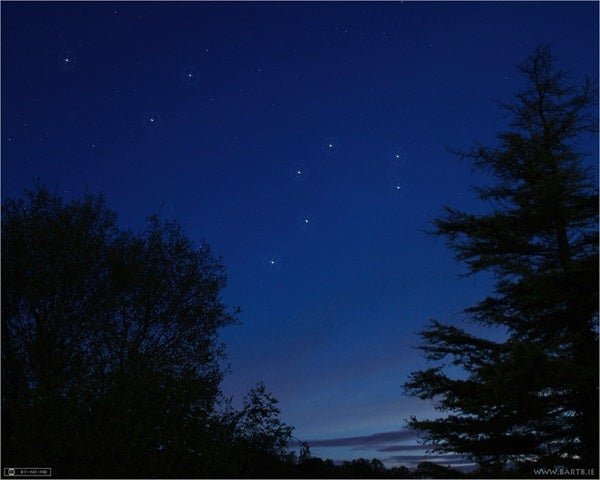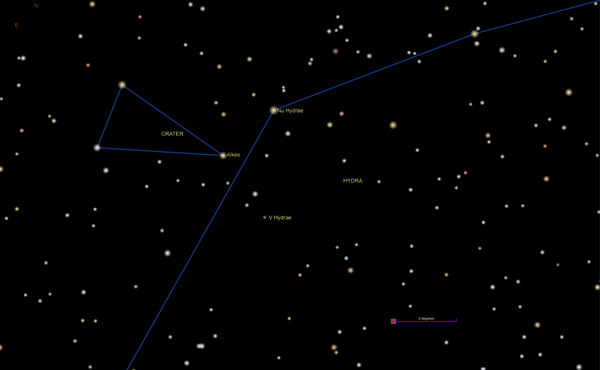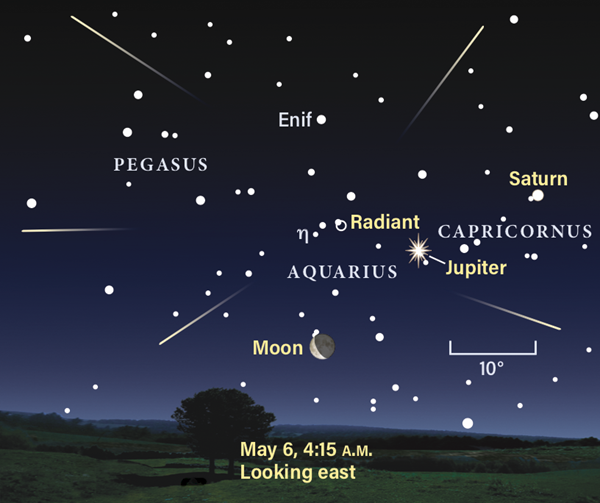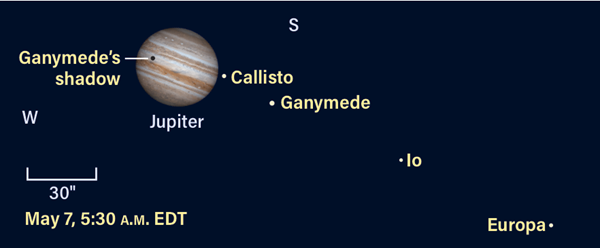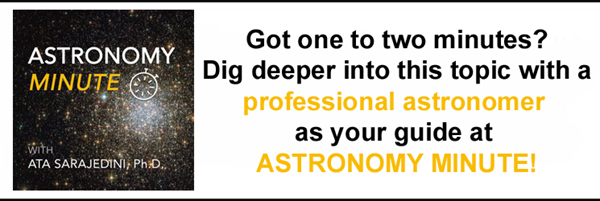Friday, April 30
Mars rounds out the month of April about 2.5° north of magnitude 2.9 Tejat (Mu [μ] Geminorum). The planet currently glows at magnitude 1.6 and spans a small 5″ through binoculars or a scope. It’s visible all evening after sunset, setting around midnight local time.
Compare the color of the Red Planet to other nearby red stars: Most notable are Betelgeuse in Orion and Aldebaran in Taurus. But take note that both of these are sinking fast in the west after sunset, so your window to catch them is limited. You’ll have more time to look above (northeast) of Mars for Pollux, one of the Twins’ heads; however, this star is notably more golden than red. 4.5° to Pollux’s northwest is blue-white Castor, an easy-to-split binary star system whose components circle each other every 445 years.
Sunrise: 6:01 A.M.
Sunset: 7:54 P.M.
Moonrise: —
Moonset: 8:45 A.M.
Moon Phase: Waning gibbous (82%)
*Times for sunrise, sunset, moonrise, and moonset are given in local time from 40° N 90° W. The Moon’s illumination is given at 12 P.M. local time from the same location.
Saturday, May 1
May’s AAVSO variable of the month is the deep red star V Hydrae. Located in the constellation Hydra the Water Snake, you’ll find it by looking south after sunset. First, find Nu (ν) Hydrae, which glows at magnitude 3 and sits near magnitude 4 Alkes (Alpha [α] Crateris) in neighboring Crater. Then, using binoculars, slide 5° south of Nu to spot 7th-magnitude V Hydrae. V Hya gains its deep red color from its age: It is a type of cool red giant known as a carbon star for the vast quantities of carbon “soot” in its atmosphere. Carbon preferentially scatters blue light but lets red light pass by unhindered, which is why such stars appear so strikingly red.
In 1888, S.C. Chandler of Harvard University discovered that V Hya varies in brightness with a period of about 530 days. Over that time, its light changes by roughly a factor of 11. The star also has a longer period — 18 years — over which its appearance changes even more. Astronomers think the short period is due to stellar pulsations, while dimming over the long term is more likely attributed to a disk of obscuring material around the aging sun.
Sunrise: 6:00 A.M.
Sunset: 7:55 P.M.
Moonrise: 12:33 A.M.
Moonset: 9:45 A.M.
Moon Phase: Waning gibbous (73%)
Sunday, May 2
Asteroids 4 Vesta and 29 Amphitrite share the constellation Leo in May. Vesta is located near the Lion’s hindquarters, starting the month out about 14° southeast of 51 Leonis. Over the next several weeks, the 300-mile-wide (480 kilometers), magnitude 7.5 space rock will slide several degrees toward the famous Leo Triplet of galaxies: M65, M66, and NGC 3628.
Over near Leo’s heart — bright Regulus, also called Cor Leonis — is Amphitrite. It’s currently a little less than 2° to the star’s northwest and will draw closer to the luminary over the next two weeks. Be sure to check back on May 13th, when it will appear to skim close to the star, nearly (but not quite) blocking it out.
Both asteroids are moving relatively slowly and you’ll need to observe them for two to three nights to really notice their motion. They’ll be easily visible most of the month, only blotted out by the Moon’s bright light from May 18 to 21.
Sunrise: 5:58 A.M.
Sunset: 7:56 P.M.
Moonrise: 1:32 A.M.
Moonset: 10:50 A.M.
Moon Phase: Waning gibbous (62%)
Monday, May 3
A nearly Last Quarter Moon rises shortly after 2 A.M. local time in Capricornus the Sea Goat. Nearby is magnitude 0.4 Saturn, which is still bright enough to pop out against the background light. Saturn sits less than 1° from much fainter magnitude 4 Theta (θ) Capricorni and directly above magnitude 3.8 Zeta (ζ) Capricorni, once the latter rises.
Zoom in on the scene with a telescope to enjoy Saturn’s 17″-wide disk. The planet’s stunning rings span 40″ across their long axis and 11″ across the short axis. This morning, you’ll find Saturn’s largest moon, Titan, 2.8′ due east of the planet. The moon — the brightest of Saturn’s gaggle — is a relatively easy magnitude 8.4. Several other, fainter moons crowd around the rings: 10th-magnitude Tethys, Dione, and Rhea, as well as 12th-magnitude Enceladus. See how many of the small worlds you can spot with our own bright Moon nearby; come back a few days later, once the Moon has moved on, for a better view.
The Moon passes 4° south of Saturn at 1 P.M. EDT and Last Quarter Moon occurs at 3:50 P.M. EDT.
Sunrise: 5:57 A.M.
Sunset: 7:57 P.M.
Moonrise: 2:18 A.M.
Moonset: 11:58 A.M.
Moon Phase: Waning gibbous (51%)
Tuesday, May 4
The waning crescent Moon rises early this morning again in Capricornus, just to the lower right (southwest) of Jupiter, which currently lies in Aquarius. Deneb Algedi sits between them. By sunrise, our satellite is about 8.5° from the planet; the Moon will later pass 5° due south of Jupiter at 5 P.M. EDT.
While you’re out enjoying the early-morning sky, look northeast of Jupiter to spot the Great Square of Pegasus. This large asterism is bounded by four stars: Markab, Scheat, Alpheratz, and Algenib. Challenge yourself before the sky grows too light by searching out M15, a bright (magnitude 6.2) globular cluster that sits west of the Great Square and about 4° northwest of Enif, the brightest star in the Winged Horse, which marks his nose.
Discovered in 1746, M15 spans roughly 18′, which corresponds to a size of about 175 light-years at its distance of 33,000 light-years. Although it appears just at the edge of naked-eye visibility, in reality its numerous stars glow with a combined brightness 360,000 times that of our Sun.
Sunrise: 5:56 A.M.
Sunset: 7:58 P.M.
Moonrise: 2:57 A.M.
Moonset: 1:05 P.M.
Moon Phase: Waning crescent (41%)
Wednesday, May 5
The Eta Aquariid meteor shower peaks tonight, but the best time to catch the most shower meteors is actually early tomorrow morning (May 6).
Since you’ll want to be up before the Sun tomorrow, get all your observing in today early in the evening. Thirty minutes after sunset, Venus is 3° above the western horizon. That’s low, but its bright glow — magnitude –3.9 — makes it easier to spot. Mercury is a dimmer magnitude –0.8, but it’s also higher, sitting 7.5° above Venus.
Fifteen minutes later, Venus is setting but the stars of the Pleiades are starting to pop out in the darkening sky. The famous open cluster sits just over 3.5° west (to the lower right) of Mercury. Also visible now is bright red Aldebaran, the eye of Taurus the Bull, as well as the Bull’s two horn tips, Elnath and Alheka. Look above them in the sky and you’ll spot Mars, still shining at magnitude 1.3 near the feet of Gemini the Twins.
Sunrise: 5:55 A.M.
Sunset: 7:59 P.M.
Moonrise: 3:28 A.M.
Moonset: 4:09 P.M.
Moon Phase: Waning crescent (31%)
Thursday, May 6
Catch a springtime shower as the Eta Aquariids’ radiant, located in Aquarius, rises three hours before dawn and two hours before the crescent Moon. You’ll need to wait an hour or two to let the region climb higher in the sky for the best viewing. This will attenuate the expected rate of 50 meteors per hour, but you’re still likely to see several good ones. Look especially for meteors that leave long, glowing trains for several seconds after they shoot through the sky. The Eta Aquariid meteors are generated by debris left behind by Comet 1P/Halley, which is also responsible for another shower: the Orionids, which occur every October.
Also in Aquarius are the crescent Moon and the planet Neptune. An hour before sunrise, our satellite sits 7.5° southwest of the planet, which glows a dim magnitude 7.8 and requires binoculars to find. It’s 5° east-northeast of Phi (ϕ) Aquarii and in a relatively sparse region with no nearby field stars. You’ll recognize the planet as a dim, grayish-blue star that appears markedly “flat” compared to any nearby suns.
The Moon will keep moving quickly, passing 4° south of Neptune at 2 P.M. EDT
Sunrise: 5:54 A.M.
Sunset: 8:00 P.M.
Moonrise: 3:55 A.M.
Moonset: 3:12 P.M.
Moon Phase: Waning crescent (22%)
Friday, May 7
Jupiter rises just before 3 A.M. local time this morning. Currently magnitude –2.2, it’s is a bright, easy-to-spot target, especially as it climbs away from the horizon in the hours before sunrise.
Jupiter has four large moons — Io, Europa, Ganymede, and Callisto — which are visible with larger binoculars or, more ideally, a small telescope. The shadow of Ganymede, the planet’s largest moon, is already crossing the disk when Jupiter rises this morning. But when you zoom in on the scene, you’ll see that Callisto is closer — just off the eastern limb of the planet — making you think it’s responsible for the shadow. After Ganymede, Io and Europa (in that order) are farthest from the planet, all to the east.
Callisto begins its own transit at 5:48 A.M. EDT, while Ganymede’s shadow is still traversing the disk; the latter will finally disappear at 6:17 A.M. EDT. That sight is out of reach of East Coast observers and tricky for those in the Midwest. Observers in the western U.S. will get a much better view.
Sunrise: 5:53 A.M.
Sunset: 8:01 P.M.
Moonrise: 4:19 A.M.
Moonset: 4:12 P.M.
Moon Phase: Waning crescent (15%)

